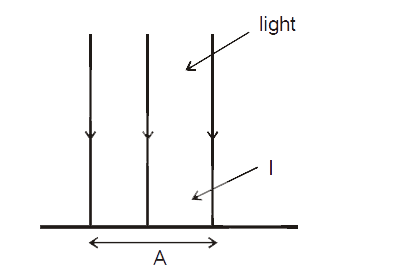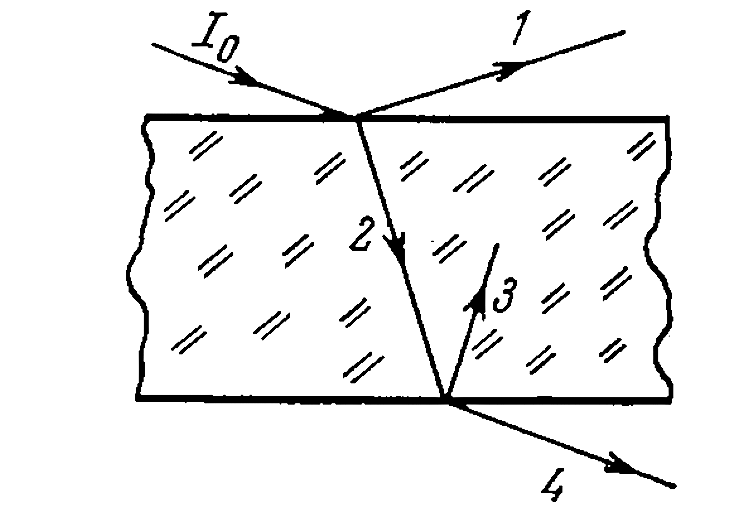A beam of light of intensity I0 falls normally on a transparent plane-parallel plate of thickness l. The beam contains all the wavelengths in the interval from λ1 to λ2 of equal spectral intensity. Find the intensity of the transmitted beam if in this wavelength interval the absorption coefficient is a linear function of λ, with exterme values x1 and x2. The coefficient of reflection at each surfcae is equal to ρ. The secondary reflections are to be neglected.
The spectral density of the incident beam (i.e. intwnsity of the components whose wave length lies in the interval λ&λ+dλ) is
I0λ2−λ1dλ1≤λ≤−λ2
The absorption factor for this component is
e−[χ1+λ+λ1λ1−λ1(χ1−χ1)]l
and the transmission factor due to reflection at the surfcaes is (1−ρ)2. Thus the intensity of the transmitted beam is
(1−ρ)2I0λ2−λ1λ2∫λ1dλe−l[χ1+λ+λ1λ1−λ1(χ1−χ1)]
=(1−ρ)2I0λ2−λ1e−χ1l(1−e−(χ2−χ1)l(χ2−χ1)'me)χ(λ2−λ1)=(1−ρ)2I0e−χ1l−e−χ2l(χ2−χ1)l
Topper's Solved these Questions
- BOOK - IE IRODOV, LA SENA & SS KROTOVCHAPTER - OPTICSEXERCISE - Optics Of Moving Sources22videos
OPTICS
- BOOK - IE IRODOV, LA SENA & SS KROTOVCHAPTER - OPTICSEXERCISE - Thermal Equation47videos
OPTICS
- BOOK - IE IRODOV, LA SENA & SS KROTOVCHAPTER - OPTICSEXERCISE - Polarization Of Light43videos
OPTICS
- BOOK - IE IRODOV, LA SENA & SS KROTOVCHAPTER - MECHANICSEXERCISE - Mechanics Problems92videos
MECHANICS
- BOOK - IE IRODOV, LA SENA & SS KROTOVCHAPTER - OSCILLATIONS AND WAVESEXERCISE - Electromagnetic Waves, Radiation36videos
OSCILLATIONS AND WAVES
Similar Questions
A plane monochromatic light wave of intensity I0falls normally on a plane-parallel plate both of whose surfaces have a reflection coeffiecient ρ. Taking into account multiple reflections, find the intensity of the transmitted light if
(a) the plate is perfectly transparent, i.e the absorption is absent,
(b) teh coefficient of linear absorption is equal to x, and the plate thickness is d.View SolutionA beam of light having wavelength λ and intensity 1 falls normally on an area A of a clean surface then
find out the number of photon incident on the surface.
 View Solution
View Solution
Knowledge Check
- Question 1 - Select One
An unpolarised beam of intensity I0 falls on a polariod. The intensity of the emergent light is :
AI02BI0CI04DZero - Question 2 - Select One
X-ray beam of intensity I0 passes through an absorption plate of thickness d. If absorption coefficient of material of plant is μ, the correct statement regarding the transmitted intensity l of X-ray is
AI=I0(1−e−μt)BI=I0e−μdCI=I0(1−e−μ/d)DI=I0e−μ/d
A beam of monichromatic light falls normally on the surfcae of a plane-parallel plate of thickness l. The absorption coefficient of the substance the plate is made of varies linearly along the normal to its surfcae from x1 to x2. The coefficient of reflection at each surface of the plate is equal to ρ. Neglecting the secondary reflections, find the transmission coefficient of such a plate.
View SolutionA narrow beam of natural light falls on the surface of a thick transparent plane-parallel plate at the Brewster angle. Its top surface. Find the degree of polarization of beams 1−4 (Fig.)
 View Solution
View SolutionTwo polaroids with their principal sections aligned at 60∘, are placed in the path of a beam of unpolarized light of intensity I0. What is the intensity of light transmitted ?
View SolutionA light filter is a plate of thickness d whose absorption coefficient depends on wavelength λ as
x(λ)=α(1−λ/λ0)2cm−1,
where α and λ0 are constants. Find the passband Δλ of this light filter, that is the band at whose edge the attenuation of light is η times that at the wavelength λ0. The coefficient of reflection from teh surfaces of the light filter is assumed to be the same at all wavelengths.View SolutionA beam of monochromatic light passes through a pile of N=5 identical plane-parallel glass plates each of thickness l=0.50cm. The coefficient of reflection at each surface of the plates is ρ=0.050. The ratio of the intensity of light transmitted through the pile of plates to the intensity of incident light is τ=0.55 Neglecting the secondary reflections of light, find the absorption coefficient of the given glass.
View SolutionA plane beam of natural light with intensity I0 falls on the surface of water at the Brewster angle. A fraction ρ=0.039 of luminous flux is reflected. Find the intensity of the refracted beam.
View Solution

